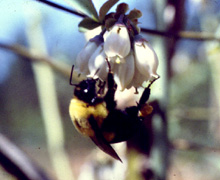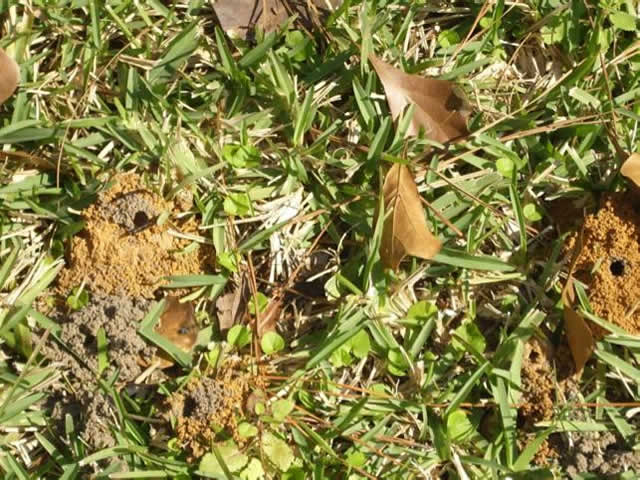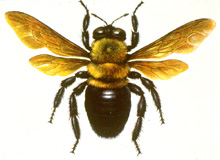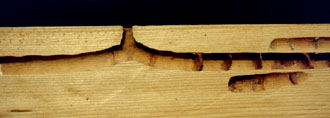Other Pollinating Bees
In general, bees need nest sites and enough food (from blooming plants) to produce offspring. These facts are the foundation of any bee conservation program.
Bumble Bees
 These large, hairy bees are common in the southern United States. These social bees are especially good pollinators of blueberry, tomato, eggplant, and pepper. Bumble bees visit flowers during rainy, cool, or windy weather when other bees stay in the nest, and they are especially good in greenhouse pollination because they do not fly against windows like other bees. In some parts of the world, bumble bees are cultured in artificial nests and used for commercial pollination, but the rearing methods are often proprietary and unpublished.
These large, hairy bees are common in the southern United States. These social bees are especially good pollinators of blueberry, tomato, eggplant, and pepper. Bumble bees visit flowers during rainy, cool, or windy weather when other bees stay in the nest, and they are especially good in greenhouse pollination because they do not fly against windows like other bees. In some parts of the world, bumble bees are cultured in artificial nests and used for commercial pollination, but the rearing methods are often proprietary and unpublished.
Rather than culturing bumble bees, Plowright & Laverty (1987) advocate enhancing their natural habitat to support crop pollination. In nature, bumble bee queens start colonies in abandoned rodent nests or similar dry, well-ventilated cavities. In early spring, one can see these bees flying slowly near the ground in search of nest sites. Growers can provide nest sites by leaving undisturbed strips of grass along fence rows, field margins, and other dry, unflooded areas.
From a bumble bee's point of view, the entire season's activities - nest founding, worker production, and food collection - are all aimed at producing next year's queens in late summer. A colony's success at queen production depends largely on its nutrition, that is, the abundance of flowers in its habitat (Bowers 1986). A prolonged shortage of flowers—common during mid summer in the South—severely reduces queen production. Farmers can benefit from growing a succession of flowering plants throughout summer. This attention to season-long bumble bee nutrition pays dividends with increased queen production and, ultimately, a large, recurring local population of bumble bees (see Establishing a Bee Pasture).
Soil-Nesting Bees

Southeastern blueberry bees look like small bumble bee workers, but they usually occur earlier in the year than worker bumble bees. They are sometimes abundant in blueberry orchards throughout the Southeast (Cane & Payne 1993). These bees are excellent pollinators of blueberry because they emerge from winter hibernation in time for early blueberry bloom, specialize on blueberry, buzz-pollinate the blossoms, and work very fast. On a per-bee basis, they are more efficient than honey bees or bumble bee queens (Cane & Payne 1990).
Bees in the genus Peponapis are about the same size as honey bees, and they are called squash or cucurbit bees because they only visit squash, gourd or pumpkin. As such, they are extremely effective pollinators of these crops. These bees make tunnels in high, well-drained bare soil and often under leaves, rocks or other objects. Their tunnels have small mounds at the entrance. Large nest aggregations can recur in the same patch year after year if it is left undisturbed and surrounding fields are repeatedly planted in cucurbits.
The keys to large numbers of soil-nesting bees are long-term undisturbed nest sites and dependable food sources. In Rhode Island, a large recurring population of Peponapis was decimated when its nest site was plowed (Mathewson 1968). Crop growers should seek out nesting areas of these bees and leave them as undisturbed bee sanctuaries. A dependable diet is also important. This is usually not a problem with more-or-less permanent blueberry orchards and their attendant populations of Southeastern blueberry bees. However, it can be a problem with Peponapis which depend on annual plantings of cucurbits. Although other agronomic considerations apply, continuous plantings of cucurbits may be advisable to build up large recurring populations of Peponapis.
Other Tunnel-Nesting Bees
 Certain bees in the genus Osmia are important pollinators of apples and other orchard fruits. They provision their cells like other solitary bees, but they nest in hollow reeds or holes in wood such as abandoned beetle burrows or nail holes. They can be induced to nest in 5/16-3/8" diameter cardboard tubes. They use mud to partition individual cells and to seal their tunnels. One important member of this genus, the blue orchard or horn-faced bee, is native to the Southeast. It is blue-green colored and has two small projections on its face.
Certain bees in the genus Osmia are important pollinators of apples and other orchard fruits. They provision their cells like other solitary bees, but they nest in hollow reeds or holes in wood such as abandoned beetle burrows or nail holes. They can be induced to nest in 5/16-3/8" diameter cardboard tubes. They use mud to partition individual cells and to seal their tunnels. One important member of this genus, the blue orchard or horn-faced bee, is native to the Southeast. It is blue-green colored and has two small projections on its face.
Blue orchard bees are very good pollinators of apple because they land directly on the anthers and stigma, thus maximizing the chance of successful pollination (Torchio 1985).
Populations of Osmia are limited by the availability of nest sites, flowering plants, mud for nest construction, fungal diseases, and fire ant predation. Research in Utah and Idaho showed that these bees readily accept artificial nests made by drilling many holes, each 5/16 inch diameter, into blocks of wood (Torchio, in preparation). Although the idea is untested in the Southeast, growers may encourage local populations of Osmia by placing similar artificial nests near the orchard. You can do this in early spring just before crop bloom so that sites are available when the bees emerge from diapause and begin foraging and provisioning new nests. The goal is large numbers of female bees nesting in the artificial holes. Don't make holes smaller than 5/16 inch diameter; smaller holes increase production of male bees which, compared to females, are inferior pollinators.
Carpenter Bees
 Carpenter bees are large bees that closely resemble bumble bees. Unlike bumble bees, their abdomens are shiny, not hairy. These solitary bees emerge in early spring, excavate tunnels in solid wood, mate, and provision nests. The value of carpenter bees in crop pollination is doubtful. They are effective pollinators of passionfruit. In Georgia, they visit blackberry, canola, corn, pepper, and pole bean, but their value on these crops is uncertain. Carpenter bees are notorious for "robbing" flowers by cutting slits in the side of the flower to reach nectar without even touching the pollinating parts.
Carpenter bees are large bees that closely resemble bumble bees. Unlike bumble bees, their abdomens are shiny, not hairy. These solitary bees emerge in early spring, excavate tunnels in solid wood, mate, and provision nests. The value of carpenter bees in crop pollination is doubtful. They are effective pollinators of passionfruit. In Georgia, they visit blackberry, canola, corn, pepper, and pole bean, but their value on these crops is uncertain. Carpenter bees are notorious for "robbing" flowers by cutting slits in the side of the flower to reach nectar without even touching the pollinating parts.
 With blueberry, robbing by carpenter bees can be a serious problem because the robbery holes attract other bee species which would otherwise legitimately visit the flower. When possible, blueberry growers should control carpenter bee populations. For infested wood in structures, inject an approved insecticide in individual tunnels, plug the holes and paint the wood surface. See your county Extension agent for help in selecting a suitable insecticide.
With blueberry, robbing by carpenter bees can be a serious problem because the robbery holes attract other bee species which would otherwise legitimately visit the flower. When possible, blueberry growers should control carpenter bee populations. For infested wood in structures, inject an approved insecticide in individual tunnels, plug the holes and paint the wood surface. See your county Extension agent for help in selecting a suitable insecticide.
